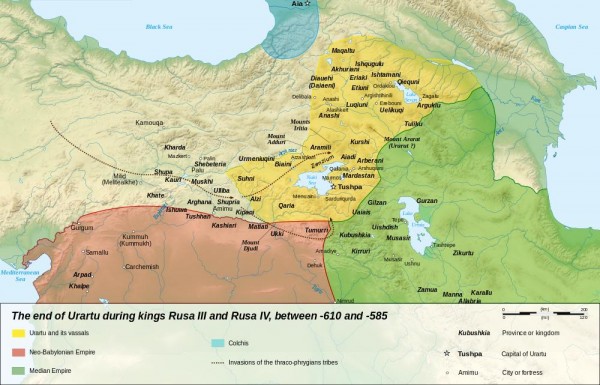
In modern times, the Assyrian people's closest ally in the middle east has been the Armenian nation. Today, mixed marriages between Assyrians and Armenians in the Republic of Armenia, Iraq and more importantly in the diaspora is relatively common as the two share a common religion (Christianity.)
Historically, the homelands of two communities overlapped
geographically and today, it is very common to have Armenians and
Assyrians living in the same villages in Syria, Iraq, Iran. As was the same case in the Van, Hakkari, Siirt provinces of Turkey before the genocides as well.
However prior to Christianity, the two were bitter foes.
The Urartu Assyria War was a conflict between the Kingdom of Urartu, the Assyrian Empire, and Assyria's successor state, the Babylonian Empire, after it was conquered.
The Iron Age Kingdom of Urartu
began its rise to power in the mid-9th century BC. Within a century,
the relatively new state had conquered the majority of the Armenian Highlands. However, the Assyrian King Tiglath-Pileser III
saw the rising Kingdom of Urartu as a growing threat to the safety of
his kingdom. The Assyrian
leadership deemed that they must end this threat through direct
confrontation with the young kingdom.
The war began around 714 BC, with the invasion of Urartu by the Assyrian King Sargon II.
Sargon led multiple offensives deep into Urartuan territory, amassing
numerous victories in the war. His early victories, especially at the Battle of Lake Urmia and his ransack of the head Uratuan temple at Mushashir, almost caused total defeat for his Uratuan counterpart, King Rusa I.
Following Sargon's death in 706 BC, however, Urartuan
Kings Argishti II and Rusa II
launched many successful counterattacks, reclaiming Urartu's lost
territory and gaining some from Assyria.
After the Uratuan victories during the early part of King Argishti II's
reign, Urartu experienced a "Golden Age" characterized by a lengthy
peace and economic prosperity throughout the remainder of Arghisti's
reign and the entire rule of his successor, Rusa II.
However, Kings Rusa III and Rusa IV were repeatedly defeated by the Assyrians. This ultimately turned Urartu into an Assyrian, and later Babylonian, client state, used as a buffer on the northern borders of these powerful empires. Beginning in 590 BC, Babylonians attacked Urartu and, by 585 BC, the Kingdom of Urartu had disappeared.
|